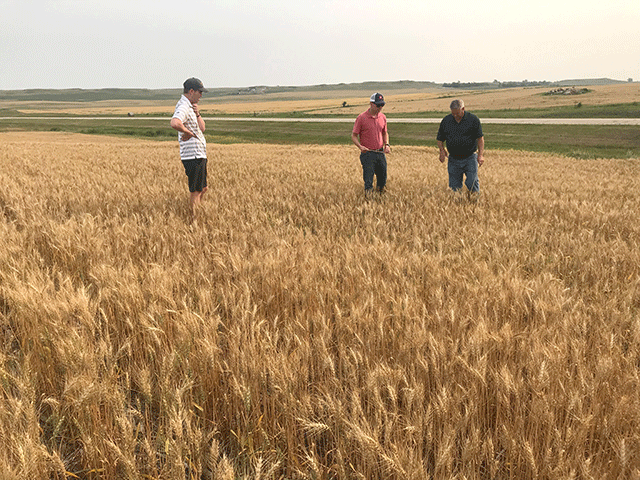Wheat Bull Hiding in Plain Sight
Wheat Comes Out as Winner of USDA's Sept. 30 Reports
The corn and soybean markets got most of the headlines from USDA's Grain Stocks report on Thursday, Sept. 30, after USDA found larger-than-expected Sept. 1 inventories than the trade had expected. Both markets sold off, while drawing attention away from the big bullish commodity winner of the day, which was wheat.
USDA cut estimated U.S. all wheat production by 51 million bushels (mb) versus the previous August estimate and found enough June-to-August consumption to drop Sept. 1 wheat stocks to 1.780 billion bushels (bb). That was 72 mb tighter than the average trade guess and 378 mb smaller than a year ago. Futures responded by rallying anywhere from 9 to 20 cents per bushel across the three traded classes and arguably kept corn from selling off further.
Let's look a little deeper into those bullish wheat numbers.
Planted acres for other spring wheat were trimmed 1.4% from last month, based on updated administrative data. A drop in other spring wheat harvested acreage had been widely anticipated due to the drought running across the wheat belt from Washington state to Minnesota. NASS cut that projection 9.4% from the previous estimate in August. Other spring includes both hard red spring (HRS) and spring white wheat, so the math gets a little murky when assigning it to classes, and NASS did not do so Thursday.
P[L1] D[0x0] M[300x250] OOP[F] ADUNIT[] T[]
Overall, harvested acreage was cut 937,000 acres. Dropping the worst-performing acres often raises the average yield for those actually harvested. In this case, other spring average yield rose 6.5% from the previous estimate, but national all wheat yield dropped 0.2 bushel per acre (bpa) to 44.3 bpa, due to the weighting of the different classes in the national number. That was still the lowest average yield for other spring since 2002.
Speaking of classes, NASS cut projected hard red winter (HRW) wheat production 27.3 mb, with soft red winter (SRW) wheat down 3.8 million. Other spring was down 12 million, with the acreage cut more than offsetting the higher yield numbers. The durum crop was revised upward on both yield (0.3 bpa) and acreage but still seen at only 37.3 mb versus 69 million a year ago. Expect spaghetti noodles and other types of pasta to be a bit more expensive and potentially harder to find.
So, what does all this mean to the national balance sheet?
The Sept. 1 wheat stocks at 1.78 bb are the tightest supply since 2014-15 for that date. The 72-mb surprise in the Sept. 1 stocks versus trade expectations doesn't necessarily mean the folks at USDA will tighten their projected U.S. ending stocks by that amount. The known change would be the 51-mb cut in all wheat production. After that, it boils down to how they allocate first-quarter consumption.
Based on limited export and food-use data to date, it appears like they would have to use 230-250 mb for first-quarter feed and residual use. We strongly suspect that wheat feeding was higher than usual in June and July due to price ratios earlier in the spring that made feeding viable (and some anecdotal reports from feedlots). That said, USDA nearly always has a large first-quarter feed and residual number and then walks it back with negative residuals in future quarters. We find out that some of those bushels eventually went to town rather than to the cattle.
The September World Agricultural Supply and Demand Estimates (WASDE) report's 29.8% stocks-to-use ratio should get tighter with this smaller production. That said, we also know that wheat export sales have not been good; export shipments through Sept. 23 were down 18% from last year at the same time. Outstanding sales commitments on the books are 26% smaller than a year ago, despite tighter exportable surpluses held by the major exporters. One must conclude that price rationing is the problem, with U.S. average cash price expected to be at least 30% higher than last year (September WASDE). The exports need to be made for the balance sheet to remain tight and justify the prices!
The market rallied Thursday on the tighter numbers, but we have to assume that the dog is on a fairly short chain until export sales come along to support the rest of the numbers.
| 2021 U.S. WHEAT PRODUCTION | ||||
| In million bushels (mbu) | USDA Actual | Average Trade Estimates | Range of Trade Estimates | August USDA |
| All Wheat | 1,645 | 1,680 | 1,628-1,720 | 1,697 |
| All Winter | 1,277 | 1,321 | 1,310-1,341 | 1,319 |
| HRW | 749.5 | 780 | 772-809 | 777 |
| SRW | 360.7 | 364 | 330-370 | 366 |
| White | 167.2 | 176 | 170-202 | 176 |
| Spring | 331 | 327 | 273-357 | 343 |
| Durum | 37.3 | 34 | 30-38 | 35 |
Alan Brugler can be contacted at alanb@bruglermktg.com
(c) Copyright 2021 DTN, LLC. All rights reserved.




